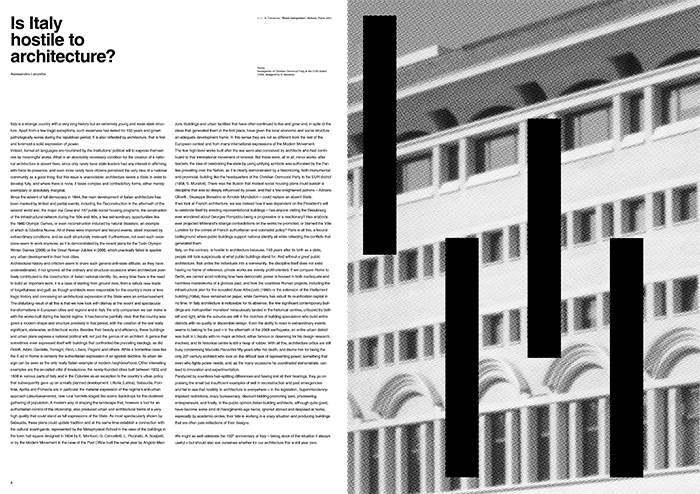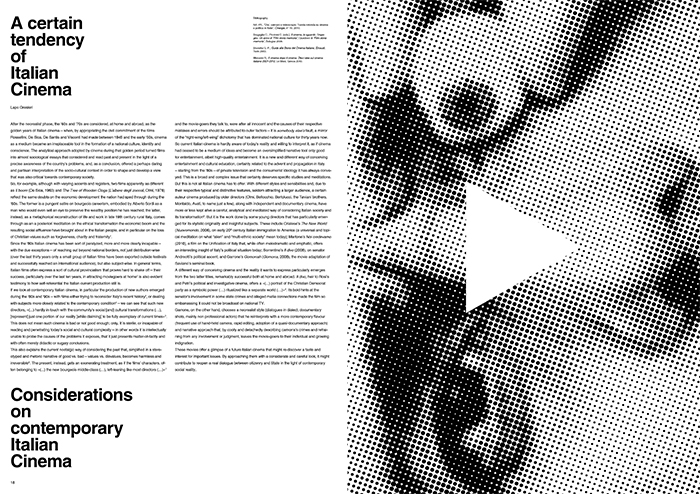|
Anno: 2012 /
Lingua: Inglese /
Pagine: 24 /
Illustrazioni a colori: 3 /
Illustrazioni b/n: 14 /
Formato: 22,5×31,5 cm /
Legatura: Punto metallico /
isbn: 978-88-95459-06-6 /
Prezzo: 10,00 € /
   


archphoto 2.0 is a print magazine spawned by the now well-established Archphoto.it, a digital webzine started in 2002 as a critical review of architecture and design issues in connection with visual arts- and social sciences-related disciplines. This new venture aims at consolidating the critical thought expressed on the web by Archphoto, that will go on and will be complemented by the print magazine’s new contributions. A debate on the theoretical discussion of the issues related to architecture and society seen from the multiple points of view of the disciplines that complement architecture: contemporary art, anthropology, sociology, photography, cinema, literature, music, design. None of the hundreds of architecture magazines currently published in Italy offers an in-depth analysis of cities’ problems and the role of architects in the transformation processes. These magazines try to attract readers with dramatic pictures of buildings, with two of the them even featuring the same design in one month. The virtual disappearance of the practice of criticism has induced a flattening of design quality – designs are never criticized, as they should be even harshly, in order to favour the emergence of the most deserving works and insights. Our magazine’s goal is to direct and define a cultural project where the top priority is the experimentation on language. Our model is Marcatrè, the magazine representing the Gruppo ’63 literary group, edited by Eugenio Battisti with the invaluable contribution of sublime graphic artist Magdalo Mussio. Only a powerful thematic analysis can make a difference between archphoto 2.0 and the other magazines. archphoto 2.0 wants to become the breeding ground of an alternative culture that confronts the prevailing system with an ambition to cross national borders and open up to the world. As Battisti wrote in Marcatrè’s first issue: “This is a Genoa-based magazine, and as such it has a specific environmental situation. Everybody complains about Liguria being isolated from the avenues of cultural activity; what little happens here hardly finds any echo on the national scene” – an unforgiving assessment that unfortunately still stands true today!
“We go to exhibitions – wrote Battisti – to criticize the judgment of curators … we do not want to sit back and watch but to act and confront today’s situation”. That’s it – act out and not make our thing in a corner, discuss problems and, sometimes, suggest possible solutions.
For the last twenty years Italian designers and academicians have lived in theoretical and media isolation and this has greatly damaged Italian architecture and the way it is perceived outside its borders. Our country’s crisis does not affect just architecture – being transversal, it reaches cinema as well as photography and contemporary art. For this reason Italy finds it difficult to abandon the stereotypes of neo-realism or Fellini’s dolce vita.
If today we fail to produce buildings that stand on their own on the international scene, it is not just because there is no adequate legislation supporting the production of public architectural works (not just buildings!) but also because architects are unable to confront their work not just in theoretical terms (where we are better prepared) but also on a practical level. This is true in terms of both architectural language and the work’s size in connection with the plan’s often urban scale, with the production of small-scale contributions (housing, redevelopment or collective housing) that fail to change their context such as Euralille, the Berlin IBA or the Bilbao Guggenheim.
1861-2011
is the title of the magazine’s number zero issue, an insight of how Italian society has changed over 150 years through its architecture and visual arts. How have Italian cities evolved/involved? Should Italy be considered a country that is hostile to architecture? We can and must write another, stereotype-free Italian history, this is why we have given this issue a blank cover. An encouragement to start again from Italian contemporary culture’s ground zero to rebuild, redesign new projects, new languages that can compete with their European, Spanish, Dutch, German and British counterparts, as well as Asian superpowers, China and India, or North and South America. Precisely for this reason we decided to opt for the “classic” radical fanzine format, Archigram-style, in English only in an attempt to start a dialogue with the rest of the world.
These are the premises of archphoto 2.0, an uncompromising, radical magazine, open to the propagation of knowledge that cannot remain confined in the isolated room of self-referential intellectualism but should build a widespread and self-aware process of cultural innovation open to society.
Editor:
Emanuele Piccardo
Contributors:
Alessandro Lanzetta
Giovanni Caudo
Antonio Tursi
Tiziana Serena
John Gossage
Guido Guidi
Cesare Ballardini
Vittore Fossati
Luigi Manzione
Luca Mori
Lapo Gresleri
Elvira Vannini
Art Direction & Graphic:
Daniele De Batté / Davide Sossi
Artiva Design – www.artiva.it
Translations:
Antonella Bergamin
|





